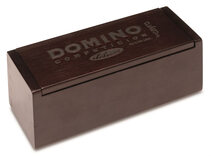Domino Rules
There are a variety of types of domino sets in use all over the world and a great number of games that can be played with them. Following are the rules for the two most commonly played games in the West - the "standard" or "Block" game and the "Draw" game. The instructions describe the games played with the standard or "double-six" domino set comprising 28 tiles, but both games can be played with a double-nine or a double-twelve set. In British pubs, these are also the most common games which are often played by four players as two sets of partners sitting opposite each other. We also give the rules for All Fives and variations - a Dominoes game that is very popular in the USA.
See also: Dominoes. See also: Mexican Train Dominoes Rules. See also: Dominoes. See also: Dominoes.
The Block Game
The Start
The dominoes are ritually shuffled face down in circles with the flat of the hand - producing a sound that has been familiar down the centuries. Each player draws 6 dominoes and places them so that the other players can't see their value. The traditional English pub method of doing this is face down in two rows of three so that all six can be picked up with both hands, looked at and returned leaving the other hand free for the equally important business of drinking a pint. Beginners can just place them on their edge in a row facing them. Remaining dominoes are termed "sleeping" tiles. The first person to play is that person holding the double-six, or failing that the double-five and so on. The tile played must be the double tile that permitted the player to take the first turn. If none of the players hold a double, then the tiles are reshuffled and re-drawn.
The Play
Each player must in turn then play a tile onto the table positioning it so that it touches one end of the domino chain which thus gradually increases in length. A player may only play a tile which has upon it a number showing at one end of the domino chain or the other. If a player plays a domino with the result that both ends of the chain show the same number (normally a number which is useful to the player and distasteful to the opponents), that player is said to have "stitched up" the ends. The way that the tiles are placed provides a small part of the entertainment. Each tile being placed must be positioned so that the two matching ends are adjacent. Unless, the tile is a double, the tile can be placed square in any one of the three directions as long as the two matching sides are touching fully. Doubles are always placed cross-ways across the end of the chain. A tile played to a double must also be placed accordingly - perpendicular to the double touching at its middle. The shape of the domino chain develops snake-line at random according to the whims of the players and the limitations of the playing surface. If a player can lay a domino, then it must be played. Otherwise the player "knocks", or raps the table and play passes to the next player. The opposing players will, of course, make mental note of the numbers currently available on the table and try to ensure that they are available in future too.....
The End
Normally play stops when one player "chips out" (plays his last domino) although some versions require both partners to chip out. If it reaches a point at which no player can proceed, the winners are the partners whose combined sum of all spots on their remaining dominoes is the least. For scoring, some pubs would play a point per game. A more interesting method, that might be scored using a cribbage board, has the winners score the sum of all spots on the losers remaining tiles. In a game which doesn't result in anyone chipping out, the winners would receive the difference between the winners total spots and the losers total spots. A game can be played to 100 points, say, or on a cribbage board, 121 points.
Variations
Games can also be played in the same way with two players (start with 8 tiles), three players (start with 6 tiles), five players (start with 5 tiles) or with four players without partnership.
The same game can be played with a double-twelve set (91 tiles) or a double-nine set (55 tiles) domino sets. With a double-twelve set, four players would pick 12 tiles each and with a double-nine set, nine tiles would be taken at the start.
The Draw Game
Really no more than a variant of the Block game, the Draw Game is more popular in many parts of the world. Players take less dominoes initially but a player who cannot place a domino must pick a sleeping domino to add to their set. When the sleeping dominoes run out, players simply pass their turn when they cannot go. For this variation, two players would start with 7 dominoes, three players with 5 tiles, four players with 4 tiles and five players with 3 tiles. The difference between the two games is that in the Draw Game, players know that all the tiles will end up in play - this enables them to better deduce what tiles other players might be holding. With the Block game, since a few tiles remain sleeping and unknown throughout the game, a larger element of uncertainty reigns.
Cross Dominoes
An extension to the Draw game, this variation gives players more options and also takes up less table space! The game is played in exactly the same way as the Draw game but with a different start. After the first doublet is played, the next four tiles played must be played against that doublet so as to form a cross. So for this first doublet only, dominoes are played adjacent to all four sides of the tile. Players may have to take sleeping tiles before this is accomplished but as soon as the cross is complete, play continues as in the draw game. Thus from that point on, each turn has four dominoes available to be played against instead of two.
Double Nine Cross Dominoes
This variation is suitable for Double Nine sets. Two or three players start with seven tiles each, four or more players start with five tiles each. Play starts as per Cross dominoes with the second to fifth tiles played forming a cross around the initial doublet. Thereafter play continues as per the Draw game but whenever a doublet is laid down, two new chains can start from it. Therefore, the number of available chains becomes much larger than for previous games. The same game starting with the same number of tiles per person should be possible with Double Twelve sets, too.
All Fives
Also known as "Muggins" and "The Five Game", All Fives is played with a double six set of dominoes by two to four players. The dominoes are shuffled face down and each player takes five dominoes (regardless of the number of players). The player with the highest doublet plays first and turns proceed in a clockwise direction. Scoring happens during and at the end of each game so it is important to keep track constantly - a cribbage board is an ideal scoring tool. The first player lays down any tile and play continues as in the Block Game with each player laying down a tile so that the tile it connects with matches in number. Players additionally attempt to lay down tiles so that the sum of the numbers at either end of the chain add up to 5 or a multiple of 5 because any such play adds that amount to the score of the player. Doublets are laid down across the direction of the chain as in the Block game and for the purposes totaling both ends count as the total of all spots on the doublet. So, for instance, if there is a 3 at one end of the chain and a 6 at the other, a player could play the double 6 which would be useful because the ends would add up to 3 + 6 + 6 = 15, a multiple of five. If there is a double five at one end and a blank at the other, a player could play the double blank so that the ends add up to 10. Should a player lay down a tile so that the ends add up to a multiple of five and fail to declare it, any player can shout "Muggins!" as soon as the next tile is laid and claim the score instead. While there are three or more sleeping tiles left in the middle of the table, when a player cannot play, that player takes a sleeping tile instead. Once there are only two sleeping tiles remaining, a player who cannot play merely passes for that turn. The game ends as soon as a player has no more tiles left or alternatively when none of the players can play a tile. The winner is the player who has no tiles left or, if no player managed to go out, the players add up the spots on their remaining dominoes and the winner is the player with the smallest total. Each loser subtracts the winner's spot total (which is zero if the winner went out) from their spot total, rounds the result to the nearest multiple of five and adds this quantity to the score of the winner. For example, if the winner has a spot total of 3, and the losers have respectively spot totals of 11, 6 and 5, the total awarded to the winner is calculated as follows:
- Loser 1 subtracts the winner's spot total of 3 from 11 = 8 and rounds this to the nearest multiple of 5 which is 10.
- Loser 2 subtracts the winner's spot total of 3 from 6 = 3 and rounds this to the nearest multiple of 5 which is 5.
- Loser 3 subtracts the winner's spot total of 3 from 5 = 2 and rounds this to the nearest multiple of 5 which is 0.
All Fives and Threes
This game is played in the same way as All Fives except that multiples of three now also count for points. So during the game, if a player lays down a tile such that the ends add up to 6, that players scores 6 points for the multiple of 3. A total of 10 scores 10 points for a multiple of five and a total of 15 scores 15 points (a multiple of five and three). At the end of the game, the winner is simply awarded the points from the losers remaining tiles or their differences on a point for point basis.
These rules are provided by Masters Traditional Games, an Internet shop selling quality traditional games, pub games and unusual games. For general information or for copying and copyright, see our Rules Information page.
Our rules are comprehensive instructions for friendly play. If in doubt, always abide by locally-played or house rules.
Copyright James Masters, 2025. All rights reserved.
There are many variations of dominos. One of the most obscure is Bingo Dominos with a Double-Six set and a cribbage board. It's based on a card game named Sixty-Six. To play a traditional game of Bingo busybeebingo.co.uk lists many new bingo sites.







































